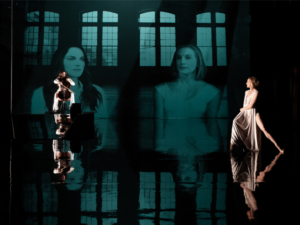Review: Elegy for Wendy Whelan

Hayim Heron; photography
Wendy Whelan is not the dancer that she was 30 years ago, nor does she have to be. As the Associate Artistic Director of New York City Ballet, which she led as star dancer for more than three decades, she can pretty much do whatever she pleases. And so she famously has since retiring from City Ballet, though her latest collaboration, with cellist Maya Beiser and dance maker Lucinda Childs, takes her further away from what her fans might expect of her.
Do the gods live? If they do, have they become mortal icons? In The Day, Whelan--who is certainly modern-day ballet's closest approximation to a goddess and icon--looks primed to answer those questions. Karen Young has costumed her in a white tunic as if she were Artemis, goddess of the hunt, and just like that solemn charioteer of the moon, Whelan wanders through space unleashing arrows with her body.
Moving beneath Natasha Katz's pale lunar lighting, Whelan acquires the image of a solitary adventurer wading through a sea of reveries. Lucinda Childs has given her a slew of prop-driven tasks to repeat, including: sliding thin silver staffs along the floor as if they are extensions of her reach, framing her body with a long rubber band, and tiptoeing in a circle while sitting on a rotating circular seat. More than a ballet, the proceedings resembled stylized theatre. All of this was accompanied by Beiser's earnest, looping strains of a David Lang composition as Joshua Higgason's black & white film was projected.
The film presented Whelan & Beiser sitting alongside each other, reciting simple phrases of accomplishments, à la "I rode a bike" or "I finally beat up that boy". Wisely, Childs refrained from instructing Whelan to mime out these words, allowing them to waft in the background as a litany of memories. Periodically action and word did sync up; a reference to playing the guitar has Whelan strumming a long band as if it were a harp string, in homage to Balanchine's Apollo. That these synced sequences occurred randomly summoned a sense of poetry at the seeming lack of contrivance and granted the audience license to sit back and watch with cool detachment as Whelan constructed a portrait of who she has become.
The overall effect was simple and not all together plaintive, though there was a sense that finality was encroaching. With each spoken accomplishment, one gathered that Whelan was divesting herself of things that no longer serve her. And so it was with her dancing as well; her legs never floated above dégagé line which could have marked conscious suppression or the expression of where her body currently is. This reduced capability did not detract from the sculptural beauty of Whelan's line. If anything, losing the taut attenuation that defined her City Ballet physique has granted her a softer quality and added dimension to her striking angularity. She looks younger now and yet resigned, as if she has nothing left to prove.
In an eerie nod to autobiography, we hear Whelan state that she has signed her resignation letter. We all know what this means; she is almost caught up to the present day, which cannot avoid feeling fraught as it signifies that there is not much further to go. Where Whelan goes from here will be determined in the years to come as audiences watch her continue to step away from who she used to be. The story goes on.
Following an extended black-out, Whelan returned to perform mismatched Lucinda Child-isms that suited her not at all. Repeated parallel stag balances and soutenu turns never looked so underwhelming. Whereas part one of The Day showed Whelan as she is becoming, part two presented her as someone struggling with a foreign style. One imagines that fans of both artists felt frustrated by the display. Beiser accompanied again, this time without a projected film in the background. After approximately 45 minutes, the evening terminated.
The Day concludes its run at The Joyce on October 27th, 2019.
Reader Reviews

Videos

